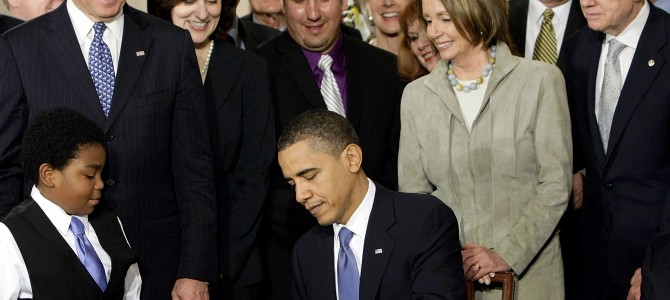
Words mean things.
That was the message delivered by the D.C. Circuit Court of Appeals in yesterday’s Halbig opinion. At issue was whether Obamacare required federal health insurance subsidies to be limited only to plans purchased via a state-based health exchange. To date, only 14 states (plus Washington, DC) have established state exchanges; the federal government established and is operating the exchange used by residents of the other 36 states. In May of 2012, the Internal Revenue Service (IRS) issued a rule stating that the subsidies would be available even if they would be applied to a plan purchased via the federal health exchange.
The panel that issued yesterday’s Halbig decision ruled that the text of the Affordable Care Act, also known as Obamacare, was unambiguous: subsidies in the form of tax credits could only be provided to offset the costs of plans purchased via a state exchange. Obamacare’s supporters immediately reacted with outrage, but they couldn’t quite settle on what, exactly, was outrageous. Some argued that the text of the law clearly permitted subsidies to flow to those who purchased plans on the federal exchange—this was the argument offered by the government in court. Others argued that while the text didn’t technically permit those subsidies, that was clearly the intent of the the law, and any textual omission was surely due to a “drafting error.”
Pity the staffer who made the drafting error in the ACA that led to the Halbig ruling. Who was it?
Blake Hounshell (@blakehounshell) July 22, 2014
New O-care setback: “Republicans are trying to take away health insurance from millions based on a drafting error” http://t.co/YmUuQpl5qE
Salon.com (@Salon) July 22, 2014
The “judicial activism” tweet wasn’t snark. What else do you call gutting a major reform on the basis of a drafting error?
Jamelle Bouie (@jbouie) July 22, 2014
@morningmoneyben tl;dr: some folks would really love it if millions of folks lost their insurance subsidies next year over a drafting error.
Brian Beutler (@brianbeutler) July 11, 2014
That’s right: a drafting error.
Let’s take a step back to see how plausible that explanation is. There are two types of exchanges: state-established, and federally established. The statutory authority for state-based exchanges comes in section 1311 of Obamacare. The statutory authority for a federal exchange in the event that a state chose not to establish one comes from section 1321(c) of Obamacare. Right off the bat, we have two discrete sections pertaining to two discrete types of health exchange. Was that a “drafting error”?
Then we have the specific construction of section 1321(c), which allows for the creation of a federal exchange. Nowhere does this section say that an exchange created under its authority will have the same treatment as a state-based exchange created under section 1311. At no point does it say that section 1321 plans are equivalent. Why, it’s almost as though the exchanges and the plans offered by them were not intended to receive the same treatment. Was that another “drafting error”?
Most important, we have the sections of the law providing for tax credits to help offset the cost of Obamacare’s health care plans: sections 1401, 1402, 1411, 1412, 1413, 1414, and 1415. And how do those sections establish authority to provide those tax credits? Why, they specifically state ten separate times that tax credits are available to offset the costs of state health exchange plans authorized by section 1311. And how many times are section 1321 federal exchange plans mentioned? Zero. Was that yet another “drafting error”?
The specific phrase “established by the State under section 1311” can be found twice in the tax credit title of Obamacare. The first instances relates to the size and the second to the scope of the tax credit subsidy. How many times is the phrase “established by the Federal government/Secretary under section 1321” found? Zero. Was that also a “drafting error”?
If it’s a drafting error, @imillhiser, why hasn’t the government made that argument in court? http://t.co/p4pnjzRH9Z #Halbig @jadler1969
Michael F. Cannon (@mfcannon) July 11, 2014
When I worked in the Senate, I spent countless hours reading through various appropriation and spending bills. I also drafted hundreds of amendments, as well as a standalone public law. During the years I spent reading through proposed legislation, it was not uncommon to find obvious errors in bills and amendments. Sometimes you would see a date written as 3015 instead of 2015. Sometimes a non-existent section would be referenced, or a section number in a table of contents might be wrong. Other times, you might see a dollar figure that had too few or too many zeroes (seriously, that happened). You might even find a misspelled word or an incorrect line number every now and again. Those were true “drafting errors,” the typos of the legislative world.
The deliberate creation of a separate section to authorize a separate federal entity is not a drafting error. The repeated and deliberate reference to one section but not another is not a drafting error. The refusal to grant equal authority to two programs authorized by two separate sections is not a drafting error. The decision to specifically reference section X but not section Y in a portion of a law that grants spending or tax authority is not a drafting error.
The clear text of the law repeatedly demonstrates that plans purchased via federal exchanges were never meant to be treated the same as plans purchased by state-based exchanges. Despite its assertions, the IRS was never granted the statutory authority to hand out tax credits related to plans purchased via a federal health exchange.
All of that of course begs the question: if the law’s authors originally intended to constrain subsidies to state plans, what was the rationale for the IRS about-face in 2011? That’s actually an easy one to answer: the administration never imagined that so many states would refuse to establish Obamacare exchanges. The subsidies for state exchange plans were meant to be pot sweeteners—incentives for states to set up their own exchanges. If fines for mandate non-compliance were Obamacare’s stick, the subsidies for state exchange health plans were the carrot. To the law’s backers, that plan made sense: the White House didn’t really want to have to manage 51 separate exchanges. They wanted the states to do all the heavy lifting. Unfortunately, several dozen legislatures and governors had different plans.
A foresight error is not the same as a drafting error.
Ramesh Ponnuru (@RameshPonnuru) July 22, 2014
When I witnessed drafting errors that went uncorrected and ended up being codified in law, I saw the same behavior over and over again: recognition of the error, followed by an immediate attempt to correct it. Usually the corrections were done via an uncontroversial “technical corrections” bill. They were almost always drafted and passed within a couple of days or weeks of the original law’s passage. But that’s not what we saw with this alleged “drafting error.” No attempt was made to rectify the alleged “error.”
The timeline tells it all. Obamacare was signed into law in March of 2010. It wasn’t until August of 2011 that the IRS decided to make tax credit subsidies available to plans purchased on federal exchanges. That’s a span of 16 months—an awfully long time to recognize and address a “drafting error.” Furthermore, actual “drafting errors” have to be corrected by new laws, not by executive fiat. Even when they are plainly obvious to everyone who sees them, that 3015 that should’ve been 2015 still has to be amended via a new law: passed by both Houses, and signed by the president. Yet, that’s not what this administration did.
In its May 2012 announcement of its official new rule which suddenly allowed subsidies to flow to federal exchange plans, the IRS never claimed it was a drafting error. It claimed the opposite: that the text clearly endorsed the IRS interpretation:
The statutory language of section 36B and other provisions of the Affordable Care Act support the interpretation that credits are available to taxpayers who obtain coverage through a State Exchange, regional Exchange, subsidiary Exchange, and the Federally-facilitated Exchange.
Moreover, the relevant legislative history does not demonstrate that Congress intended to limit the premium tax credit to State Exchanges.
Accordingly, the final regulations maintain the rule in the proposed regulations because it is consistent with the language, purpose, and structure of section 36B and the Affordable Care Act as a whole.
So why did the IRS wait nearly 16 months to spring this new interpretation on the public? That’s also an easy one. As of August 17, 2011, when its rule was first proposed, only ten states had passed laws establishing their own exchanges. Seventeen had outright rejected the Obamacare exchanges. All told, 40 states had by that point failed to do the administration’s bidding and set up state-based Obamacare exchanges.
Without exchanges in every state, Obamacare would surely fail as a policy matter. And without massive subsidies to offset the costs of Obamacare’s health plans, Obamacare would fail as a political matter. The IRS maneuver was a last-ditch attempt to paper over the law’s serious structural flaws.
The Halbig case changed all that and ripped off the facade to expose a structure ready to collapse under its own weight. And it wasn’t due to a “drafting error,” the uninformed opinions of know-nothing bloviators who’ve spent exactly zero time drafting federal legislation notwithstanding.
In 2010, Nancy Pelosi famously claimed that Congress needed to pass Obamacare in order to find out what’s in it. Well, a federal court just read Obamacare and found out what wasn’t in it: tax credit subsidies for federal exchange health plans.









